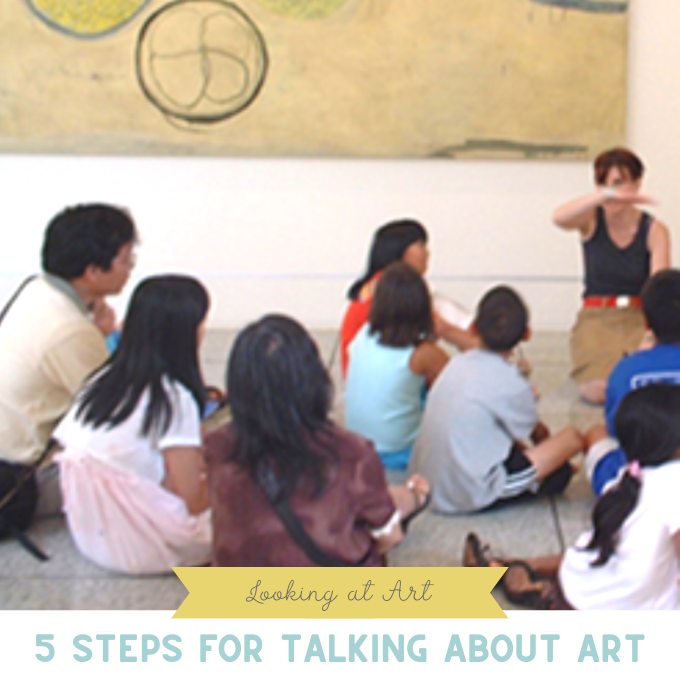
Have you taken your kids to see any good art lately? As a an art museum educator I spend a fair amount of time thinking about how adults can help children talk about and make sense of art.
Why is talking about art important?
There are so many reasons! Talking about art is good for kids’ minds: it helps them think critically, develop strong reasoning skills, pay attention to nuance, and explore new ways of interpreting the world.
However, facilitating a rich discussion about an abstract expressionist painting or a life-sized bronze statue can be daunting to many adults who don’t feel like they have enough knowledge about art to share it with their children.
Does this describe you?
Well, here’s a little secret…
Information is not important. What’s important is helping children find ways to describe what they see.
If you understand a basic methodology for discussing art with kids, you’re good as gold and your children will enjoy the process of discovery that unfolds.
I’ll give you an example: There’s a new wall-sized installation at the Stanford Business School by artist Peter Wegner. On a recent walk through campus, it caught my attention and captured my 3-year old’s imagination.
Moving Sculpture at the Graduate School of Business from Stanford Magazine on Vimeo.
Pretty cool, right? I hadn’t seen it before and wasn’t prepared with any questions or ideas before discussing it with my daughter. We were both curious about what it was and how it worked, so we stepped up close to take a good look at it.
Start with what you see.
I noticed that the color chips were flipping like pages in a rolodex (remember those?!), and that the whole thing morphed in seemingly endless ways.
It was mesmerizing. N didn’t say much, but after she looked at it for a few minutes I asked her, “what do you see?”
She noticed that the colors were shifting, wanted to know how the colors moved, asked where the on/off switch could be found, mentioned the sound, wondered about the label, and asked if she could touch it. As you can see, there were a lot of questions! And a lot of questions that I didn’t have answers to! I turned a lot of her questions back around at her, which compelled her to think critically and look more carefully at the artwork.
Here’s a conversation example:
Me: “How do you think the colors can move?”
N: “Maybe someone is behind the wall, pushing the colors forward,”
Me: “What do you see that makes you say that?”
N: “I think someone has to be back there because I can’t see how it moves.”

It didn’t matter if she was wrong or right; what mattered is that she was invested in the artwork enough to think for herself and think critically about the piece by reasoning through her ideas.
After we chatted more about her questions, I suggested that we step far away from the piece and look at it from a different perspective, and then I again asked, “What do you see?”
This time she talked about how small everything looked, how she could see everything at once, and which colors she could see the most of at any given moment.
Because she noticed the label when we first began our conversation, we walked back up to the installation to talk about it. I explained what I could about what I read. I shared that we can look for labels next to art pieces in sculpture parks and museums in order to find clues about the artwork. In this case, we could find out the artist’s name, birth year and place of birth, title of the piece, year it was made, and the materials the artist used. But that’s all the label had to say…there’s so much more that can be discovered through close observation.
When we got home, she wanted to make her own color installation, so my husband suggested post-it notes as the medium. She loved this idea, requested a step ladder, and began sticking a sea of color on one of our walls.
The methodology I used with N is grounded a research-based teaching strategy called Visual Thinking Strategies. I’ve used this strategy with children and adults for years and have seen it pull amazing ideas out of the quietest participants. It’s usually introduced to children when they reach Kindergarten, but you can try it as I did with younger children who can carry on a conversation.
Five Easy Steps for Talking with Children About Art
- Find real art. Looking at a real piece of art can be a far richer experience than looking at a reproduction (like a poster). You don’t have to go to the “best” museum to make this happen, just find something that captures your child’s imagination. Talk about art in your home or look for a public sculpture in a town square.
- Be open-minded. Expect that the child will have his or her own ideas about the art, and try not to interject your own ideas of wrong + right into the conversation.
- Encourage careful looking. Get up close or take a look from a different perspective (up high, the side, far away, walk around it)
- Ask open-ended questions such as “What do you see?”, What’s going on in this picture/sculpture/installation/etc.”and exploratory questions such as “Do you have any ideas about how the artist made this?”, “If you could add something to this artwork, what would you like to add?”, “If this artwork could talk, what might it say?”, “What would you title this piece?”
- Look for an opportunity for related art-making. Making art can help strengthen a child’s understanding and critical thinking skills as they interpret what they saw in two or three-dimensions.

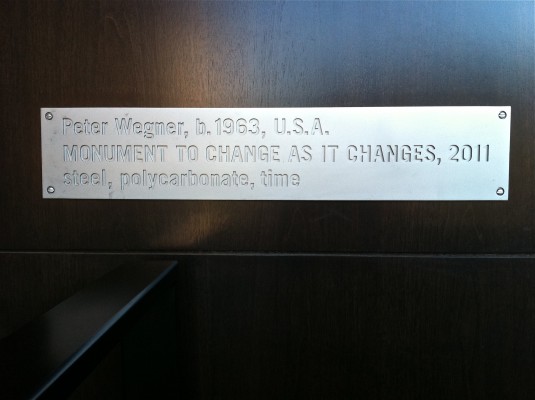
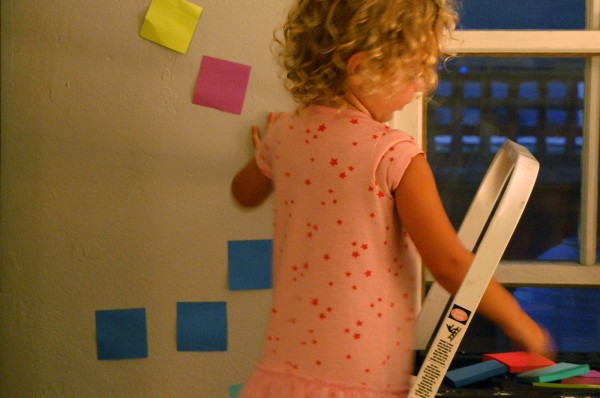
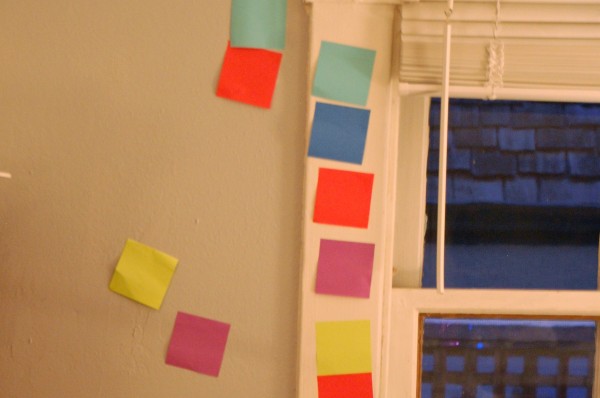

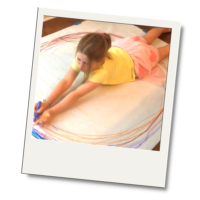
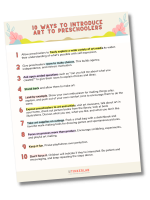
i love this entry, rachelle! the phenomenological approach to the image (“what do you see?”) is so important as a first step to keep in mind when talking with children about art.. and in talking about your child’s art with them. just as this open (less structured, more imaginative!) way of asking children to consider what they are seeing in art, this approach also frees us from making our own interpretations about the images our children create. thank you for this wonderful example, list, and reminder.
oof, grammar error in that last (run on!) sentence up there… i think you get what i mean though! 🙂
I haven’t heard about this as a phenomenological approach before, and like learning new things. 🙂 It does free us from making interpretive remarks when looking at art with children, or when discussing the art that they make. All it takes is asking the child “what’s going on in this picture?” to discover that our own interpretation is often MILES away from what the child is thinking about.
the phenomenological approach art images is one way of working as an art therapist (with artists of all ages) that i have also found useful in working with my daughter when looking at art — hers and others. there are many articles and books on the topic in the art therapy realm of literature.
mala betensky writes about it quite a bit. here’s a chapter of hers on the topic in one of judy rubin’s books: http://books.google.com/books?id=kTYI3nzRgLUC&pg=PA121&lpg=PA121&dq=phenomenological+approach+art+therapy&source=bl&ots=6Is9ZT0GTl&sig=WTfyAxj6gCa4EvbLaFvBxZTuRd4&hl=en&ei=lo3BTuHCCuiWiQLVzKGhAw&sa=X&oi=book_result&ct=result&resnum=4&ved=0CD0Q6AEwAw#v=onepage&q=phenomenological%20approach%20art%20therapy&f=false
and an entire book on it that betensky wrote:
https://www.amazon.com/What-You-See-Phenomenology-Therapeutic/dp/1853022616
another:
http://www.springerlink.com/content/tg10t282j3658673/
etc…
i am loving the post-it notes, by the way!
Rachelle, this is great, and I’d add it’s a good way for adults to approach artwork as well. In general I think once we, as adults, step out of that role we often feel we need to take on as teacher, everything gets easier. When you’re just parent & child discovering together, and you dismiss the idea that anyone is supposed to have all the answers (as if!!), it’s so simple, really.
Also, hurrah for art in public spaces! When we went to URI’s Grad School of Oceanography’s open house in the spring, we were so amazed by a new sculpture there. It’s described here, if you’re interested, although the pictures really don’t do it justice: http://www.uri.edu/news/releases/?id=5887
Thank you, Amy! And you’re absolutely right — I’ve used this approach with adults and it works wonders with us grown-ups too. A lot of us don’t know how to really “look” at art (we get too bogged down with what we’re “supposed” to think or see) and this strategy frees us from prior knowledge. Thanks for sharing the link. I’ll check it out. You’re lucky to have good public art in your neck of the woods!
This is a great article. It’s so important that children are exposed to as much art as possible. Art inspires and excites us. I just wanted to point out the importance of keeping this experience as fun as possible. I’ve been an art teacher for 10 years, and I’ve found myself learning some tricks along the way. Follow your child’s pace around the museum. It is way more important for the child to have an awesome experience, than it is for them to stop and look at every painting. It’s also a good idea to think of other places you can see art besides museums. Outdoor sculptures are great. Also, consider visiting a studio of some sort, so the kids can meet an artist and see where they work.
You’re so right, Michelle. It has to be FUN. I didn’t emphasize this enough, but it’s what I was getting at in step #1 with finding something that captures a child’s imagination. If they’re not interested in the art to begin with, the whole conversation will run its course in about 3 seconds. Thank you for sharing this really important point — it could be a whole post of its own!
What a smart post! I’d never considered color installation play- the discussion and the home execution with post-it notes is brilliant.
Thanks for the kind comment 🙂 We had a lot of fun!
love it Rachelle, it’s really true how you describe this process on bringing art to a little one. Letting go of all expectations and daring to be open…
Beautiful video also and the idea with the post its is great!
I stumbled the post,
Angelique
thanks for the stumble! letting go of expectations can be harder than it sounds, but it’s well worth the effort.
Rachelle- thank you! I love this post as well as the insightful comments. It sure is freeing for us, as adults, not to feel like have to be all knowing. We can experience the art with our kids and enjoy seeing from their unique perspective if we are open to it.
that’s exactly it, alissa…it frees us from having to know everything. kind of counterintuitive to many adults, but it works!
I love your post and thanks for including the link to Visual Thinking Strategies. I will definitely be spending some time having a look at that.
i’m always happy to share, and glad that the VTS link is helpful.
Love that art work! How cool is that? I love finding art in other places besides museums because it always seems more special . C loved the art museum when we went and especially loved the outdoor sculptures. I want to take her to a sculpture garden that I know she would love. Back in my art Ed days we learned Describe, Analyze, interpret, and Judging when looking at art. I don’t even know if this is still taught? (you’ll have to update me…or I’ll just take a gander at your link) Great post!
The artwork is soooo cool. Isn’t it lovely when we’re surprised like that? It’s like being on vacation. I remember Describe, Analyze, Interpret, and Judge very well. I used it as a tool in my last docent training class — it’s a great way to break an artwork down into easy-to-chew chunks, but I’m not sure if/how it’s used at the college level. I imagine it’s still in use with the art history crowd. Hmmm. Now I want to know.
Hi Rachelle! What a great post. I work at the Dallas Museum of Art, specifically with children under 5, and these are the same techniques I use. I am always amazed when they pick out something that I didn’t notice before, or ask an intriguing question that I want to know the answer too as well. I think it’s so important for parents to start early, and like you said, not be intimidated.
On another note…here’s a book that has completely changed my way of interacting with children and encouraging them in their exploration of the world and their own creativity: “New World Kids” by Susan Marcus. From following your blog, I think you’d really like it!
Hi Leah! We must have a friend in common. Do you work with Susan D? She actually recommended that book to me (I think it was written by a Dallas-based educator?). ! It’s on my shelf and I must admit that I’ve barely cracked it open, but after reading your comment I’ll pull it back out again and take a closer look. So glad you’re part of this conversation.
This is a wonderful post. Thank you for all of the wonderful tips!
Kids are so creative, we were too when we were kids 🙂 But we just grew up one fine day…
To nurture and to cherish their creative outpours I would like to share http://www.littlesketchers.com with all the Artful parents out there…Do stop by!
Thanks!
Thanks for this. Â So easy and inspirational. Â I think nothing can beat true life authentic experiences.Â
Love the question “What do you see that makes you say that?” — evidence based interpretation, yes! Though I agree wholeheartedly with your #1, we also used Baby Einstein’s art books to talk about some classics, and Denise Fleming’s books to talk about art around us. Carry on, loving it! xx a
Thanks for the thoughtful comment, Angela. Yes! I agree that looking at art in a book is also fabulous, and you can have a lot of rich conversations with images from books or in museums. You’re reminding me that my kids and I will often stop while reading books to discuss the meaning of the images…these conversations are spontaneous and contextual, and evidence that my kids are thinking deeply about what they see.
Your steps are fab! Thank you. I am going on a school trip to a gallery with my class of 30 8 year olds and am frantically trying to think of activities for them to do. These questions have really given me a great starting point.
Thank you
Most importantly, in the event that you detect, the keep cann’t just accommodate the need of sportsmen when it comes to outfits but additionally provided households with a broad variety of these things to begin with.
Visiting down to the timber alone isn’t advised
as there are true woodland pets that livein the woods such as cougars, contains, as well
as other wild animals.
A standard collage framework usually is recognized as to look a lot more
cosmetic, maybe even more specialist.
You know how essential search engines aгe.